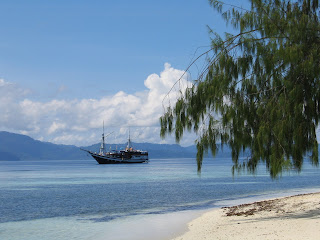

My first foray into diving Indonesia was an organized group to Wakatobi in South Eastern Sulawesi. Suffice it to say the location did not live up to the expectations built up by a glossy set of brochures and promotional images. Still the area around Sulawesi was touted as the mother lode of bio-diversity and a true must see for an underwater photographer.
In late 2007 I booked a trip to head to the edge of nowhere and join an Equator Crossing charter on Raja Explorer to the Raja Ampat area. I did not have WIFI and could not blog as we were at sea for 12 days touring the area around Misool back up to Kri Island and Sorong, so I will offer here two handwritten journal entries that stand out from this trip. Weather impeded a fabulous dive experience, but it was still one of the most fabulous places to discover.
Finding paradise in Papua
Unable to dive due to a severe sinus squeeze, I availed myself to a break in the diving schedule and ventured onto Mioskon Island for a shore exploration. It just happened to be a quintessential tropical evening , with not a breath of air stirring the mirror like surface of the se. We landed on a powder white sandy beach, the small islet was covered in dense jungle foliage and birds called out as the sun lowered due West. The landscape glowed in a golden precious light only seen at the close of an exquisite tropical afternoon.I lowered myself over the edge of the small tender and waded carefully though warm crystal clear water , sinking up to my ankles in soft sand before I reached the shore. The narrow beach was strewn with an even ring of coral shards, broken shells, sea grass,tree and palm fronds, and regrettably, refuse items one finds everywhere, even on this remote little island jewel off Western Papua.
I had hoped to find some sea shell specimens for my altar at home. Gazing down on broken bleached shell fragments , I strolled further around the shoreline. Several trees were down and the trunks made crossing impossible.A small trail led off into the trees and I followed it . The birds were singing loudly, "sundowning", and they were obscured from view by the dense green canopy overhead.
I found a few interesting specimens: one round white coral knob with a hole in the middle resembled a modern sculpture.I continued to comb through the rubble and soon gathered a small handful of delicate striped shells.I had not taken my camera with me, although this was the most idyllic setting we had encountered on the trip.I did not want the distraction of taking images, but rather chose to immerse myself in my surroundings. I only wanted to see, to gaze at the beauty of nature with awe and reverence.I could feel the evening dissipating the heat of day, smell the plants and flowers.I felt in this setting a mystery, yet also a knowing of some order or force which created such utter perfection.
The sun slid below the horizon line as a huge crimson orb, turning the entire sky rose and lavender. As the tide was ebbing we had to leave. I waded out clutching my little shell collection, when , on the sand before me lay the most perfect and beautiful shell of all. It was a large spider crab shell like the ones I had found in the maldives.I stopped happily to pick it up. It was unblemished,colorful, intact, exactly what I was searching for . The shell had been lying there next to the pile of rubble and garbage, on this quiet beach on a perfect evening, waiting for em to find it.I cradled it carefully on the ride back to the boat.I wished on the evening star as it peeked out of the twilight, believing in all possibilities for my future.






.JPG)











